No ceramic lover can resist the timeless charm of a Renaissance portrait finely painted on a Deruta ceramic.
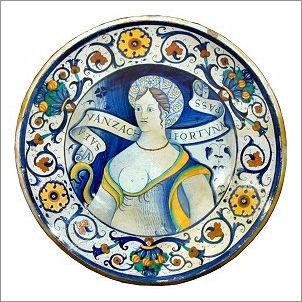 Scattered all over the world in the most prestigious museums, Deruta portrait ceramics share the same taste for proportions, the gentle forms, the harmonious colors, the fine heads and sweet gentle faces expressing utter serenity and selflessness.
Scattered all over the world in the most prestigious museums, Deruta portrait ceramics share the same taste for proportions, the gentle forms, the harmonious colors, the fine heads and sweet gentle faces expressing utter serenity and selflessness.
During the Renaissance portraits were one of the favorite subjects of Deruta potters, less keen on painting historical scenes (istoriato) which, on the contrary, were the pride of Gubbio, Casteldurante, Faenza and Urbino.
Before going through the reasons why Deruta pottery was so different from other Umbrian ceramics, it’s necessary to take a step back and focus on the revolutionary impact of the Renaissance on the contemporary lifestyle.The central feature of humanism in this period was the commitment to the idea that the Greek and Roman intellectual achievements should be taken as a model by contemporary Europeans.
Fine arts revived the Classical values and artistic styles and developed the use of proportion, perspective and chiaroscuro in the accurate portrayals of figures and landscapes.
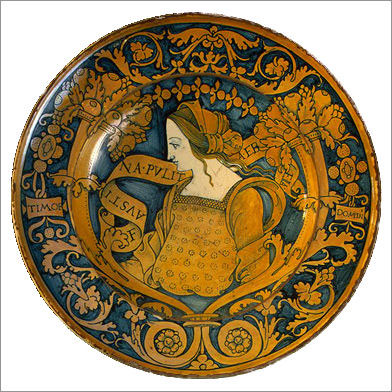 The new geographical discoveries (America!) and the increase of trade between nations during the early Renaissance created a new wealthy mercantile class, eager to govern over the rising urban communes and increasingly demanding luxury goods.
The new geographical discoveries (America!) and the increase of trade between nations during the early Renaissance created a new wealthy mercantile class, eager to govern over the rising urban communes and increasingly demanding luxury goods.
Italian ceramics became the ideal artistic medium of the Renaissance society. Through pottery, the fine art values and the spirit of the Renaissance entered the houses of the new social classes. Well crafted, elegantly decorated, Italian Renaissance ceramics gained the status of an art form. They became a fashionable item.
Lavishly decorated dishes, apothecary jars, handled vases and bowls were displayed prominently by citizens from all levels of society and swiftly traded all over Europe.
Potters closely followed the works of the most popular painters, more or less freely reinterpreting them in their ceramics.
This was particularly evident in Deruta ceramics, which were deeply influenced by Perugino and Pinturicchio paintings, both active in Perugia and having personal relationships in Deruta.
Although their influence on Deruta ceramics was not limited to the choice of portraits as favourite subjects, it certainly accounts for the superior quality and distinctiveness of achievements of the local potters.
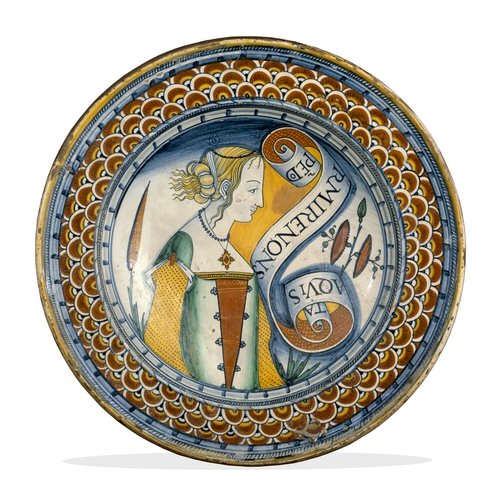 Perugino’s skill in depicting the human body and flesh tones, both in religious paintings and in secular portraits, was extremely original and explains his first, dazzling success in Rome. He became the most sought-after painter in Italy, and the most expensive. Nonetheless, Perugino never abandoned his home turf, and was to spend much of the rest of his career in Umbria, mostly in Perugia.
Perugino’s skill in depicting the human body and flesh tones, both in religious paintings and in secular portraits, was extremely original and explains his first, dazzling success in Rome. He became the most sought-after painter in Italy, and the most expensive. Nonetheless, Perugino never abandoned his home turf, and was to spend much of the rest of his career in Umbria, mostly in Perugia.
His vision and techniques were to nurture the talent of one of his pupils, Pinturicchio, who rapidly became very famous himself. From his finely decorated figures glistening with gold, Deruta potters got the inspiration for their beautiful yellow-gold lustres and the taste for details in portrait painting.
Please, don’t jump to the conclusion that the relationship between Deruta potters and Perugino’s and Pinturicchio’s painting was merely based on a common artistic taste, though. It was also very practical, indeed.
Deruta and Perugia are very close, so it was very easy for Deruta potters to get the cartoons of the original frescos and copy them.
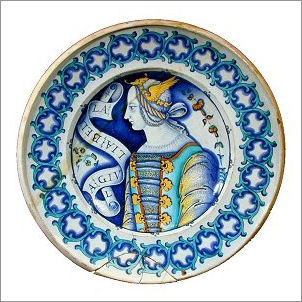 It was also very easy to go and see the painters’ works in Perugia and the surrounding cities. As a matter of fact, Perugino’s frescoes in the Collegio del Cambio in Perugia supplied potters with a huge number of models for their Deruta pottery (Saints, Ladies, Warriors…) and so did Pinturicchio’s paintings in Spello.
It was also very easy to go and see the painters’ works in Perugia and the surrounding cities. As a matter of fact, Perugino’s frescoes in the Collegio del Cambio in Perugia supplied potters with a huge number of models for their Deruta pottery (Saints, Ladies, Warriors…) and so did Pinturicchio’s paintings in Spello.
Last but not least, Perugia was also the major trading center in the region, and it was much easier to sell Deruta pottery which was sure to meet the local tastes, which were dominated by the “new” techniques and styles masterfully interpreted by Perugino and his pupils.
Although sometimes the portraits painted on Deruta ceramics were very similar to their source of inspiration, they rarely were mere copies.
Deruta potters were among the best in Italy. They had been refining their skills generation after generation. Moreover, the protection and encouragement granted by the Baglioni, Lords of Perugia, to Deruta ceramic trade attracted to Deruta many technically and artistically gifted potters.
Their talent added much to their beautiful models. They also developed a technique to satisfy the increasing demand for the most popular subjects without making copies. Using the “spolvero” technique they could repeat the same basic drawing on their ceramics, which they personalized and differentiated in the painting stage.
Worth mentioning is the name of Nicola Francioli, a.k.a. Co’, who worked in Deruta in the first half of the 16th century. His art was deeply influenced by Perugino’s and Raphael’s works, which he originally reinterpreted in his ceramics.
His works, together with some other masterpieces in portrait ceramics from the Renaissance are on display at the Museum of Ceramics in Deruta.
Francioli has been one of the first artists to embody the expressive independence of ceramics from the finer arts and to turn Deruta pottery into “One of the purest expressions of Italian Renaissance culture”, as stated by Laurence Kanter, curator of the Robert Lehman collection at the Metropolitan Museum of Art in New York.
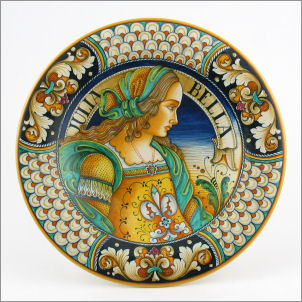 Today, only a few potters in Deruta own the technical skills to achieve good results in Renaissance style portrait painting. Still, the tradition is alive.
Today, only a few potters in Deruta own the technical skills to achieve good results in Renaissance style portrait painting. Still, the tradition is alive.
We are actually very proud to feature in our site the works of Alvaro Binaglia, whose talent in portrait painting won him a place in Deruta Museum and the preference of many collectors of Renaissance style majolica.

i have a plate spelled dervta and also on it, It says made-in italy,,and than am saying number 7 under it ,,who made it? and is it rare?…thank you,
Can you tell me who Julia Bella was and why her portrait is on Deruta ceramic plates?
Thank you
Very stimulating comment!
Most likely Julia Bella was Giulia Farnese, one of the most intriguing female characters of the Italian Renaissance.
“Julia the Beautiful” was charming and very much admired by her contemporaries. Her beauty won her the life long love of Rodrigo Borgia, first Cardinal, then Pope with the name of Alexander VI. Using her influence on the Pope she managed to build a large fortune for her family, both in terms of land and noble titles. Her greatest achievement is perhaps the Pope created his brother Alexander a Cardinal.
Her legendary beauty inspired the painter Raphael and Pinturicchio.
Thank you for the information. Julia Bella must have been very beautiful to have been the source of such inspiration.